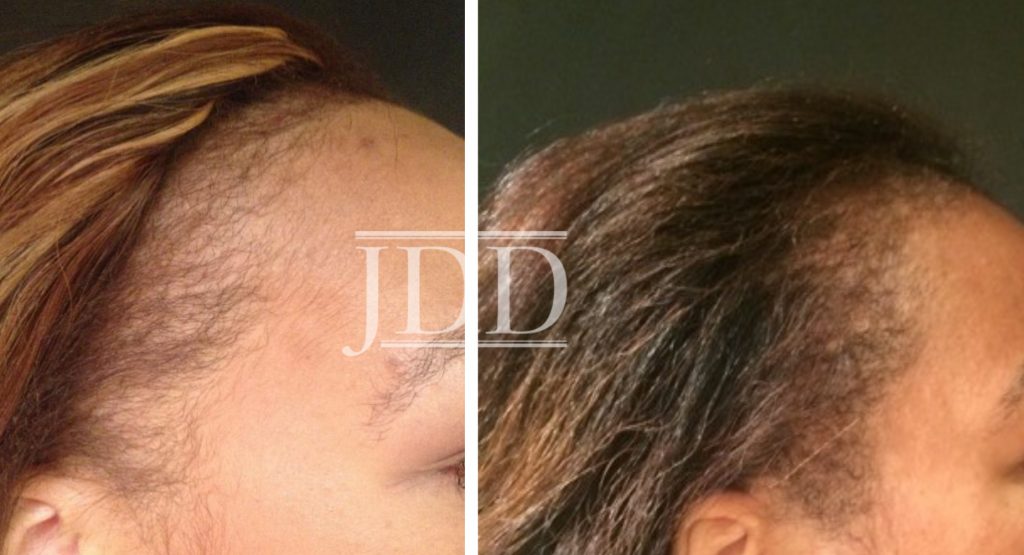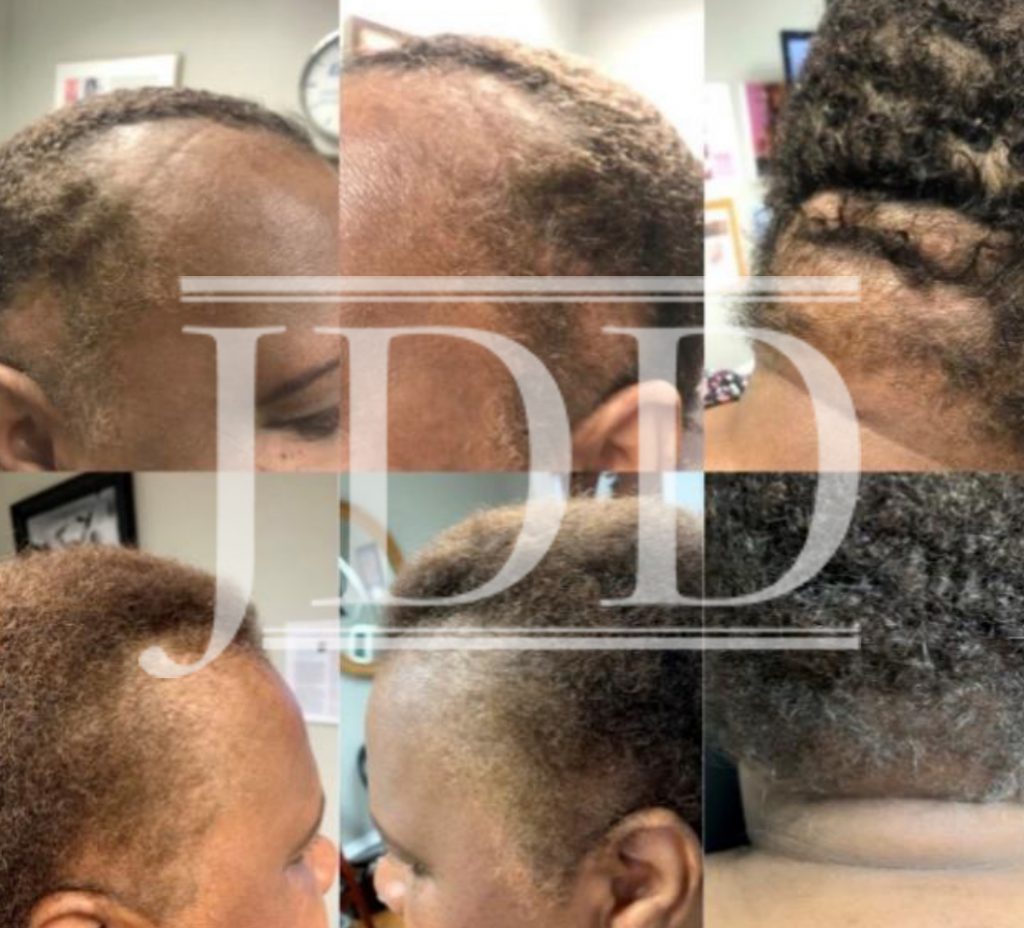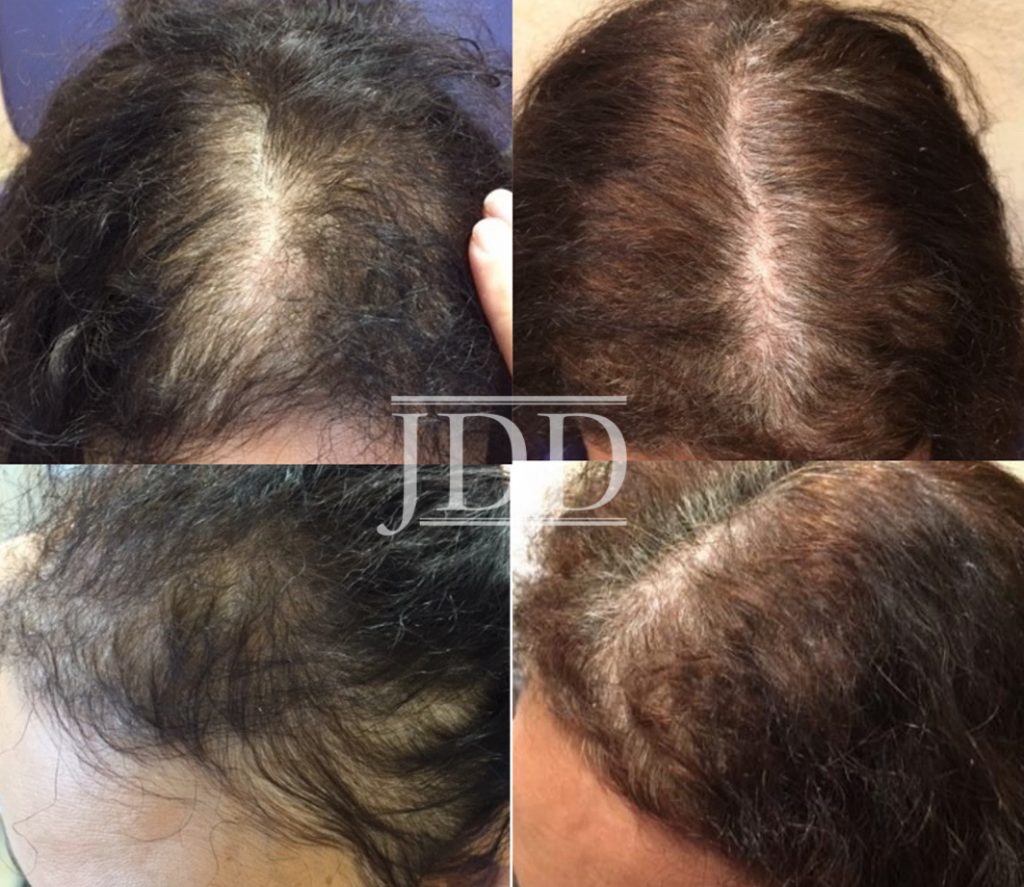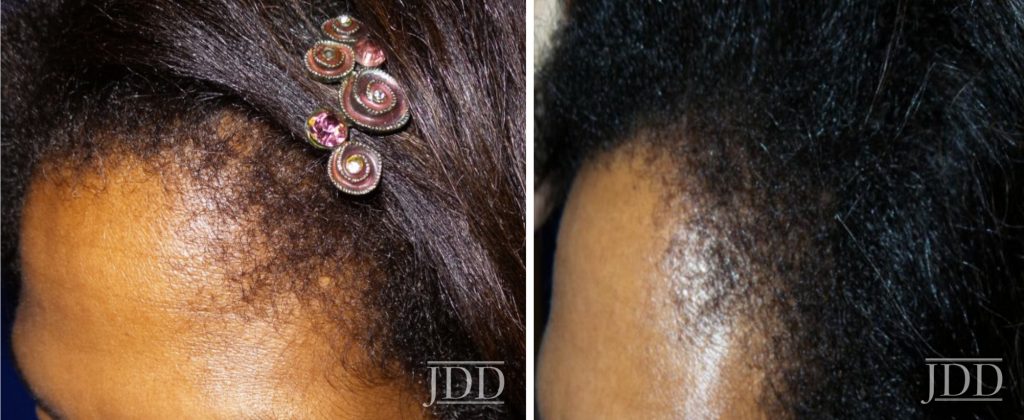Hair loss is a common problem that spares no gender or ethnic group. As we know, there are differences in straight and curly hair including follicle shape, growth rate, and density.2Similarly, there are also differences epidemiologically in what types of hair loss are more commonly seen in different ethnic groups, as well as how it’s diagnosed and treated.2 JDD authors Cheryl Burgess MD, Wendy Roberts MD, Jeanine Downie MD, Megan Kera PA-C, Sophia Kogan MD, and Danamarie Belpulsi MD present four African American female patients who consistently ingested a nutraceutical for 3 months, 10 months and 2 years after experiencing significant hair loss and failed previous treatments.
Introduction
Hair loss is a common problem that spares no gender or ethnic group. As we know, there are differences in straight and curly hair including follicle shape, growth rate, and density.¹ Similarly, there are also differences epidemiologically in what types of hair loss are more commonly seen in different ethnic groups, as well as how it’s diagnosed and treated.2
However, hair loss among the various groups can result in the same psychosocial distress leading to depression, anxiety, and frustration often further precipitated by the limited availability of treatment options that traditionally produce variable results with a chance for side effects. According to the American Academy of Dermatology, a 2016 survey showed that almost half of African American women experience hair loss, while only few bring it to the attention of a physician.2,3 In fact, African American women are prone to hair loss, which can be compounded by certain styling practices. Most importantly, this population has the highest risk of central centrifugal cicatricial alopecia (CCCA), marked by inflammation and progressive destruction of follicles through scarring – limiting treatment options further when diagnosed late or not at all.2,3,4
While the presentation, morphology, and prevalence of hair loss vary within different ethnic groups, science shows that etiological factors are still numerous regardless of ethnicity. They include genetics, hormones, psycho-emotional stress, environmental factors, inflammation, oxidative damage, as well as lifestyle and styling habits, to name a few.5,6 Sadick et al describes the research behind the ever-growing number of pathways involved in the undermining of a healthy follicle. He and colleagues call for a paradigm shift in therapeutic approach to hair loss from mono-targeting to multi-targeting interventions, to reflect the multi-factorial nature of all types of hair disorders.5,6 The multi-targeting nature of these interventions supports their use in any patient population, regardless of age, ethnicity, gender, etc.
In this case series, attempting to highlight one particular hair type- African American, which has the slowest growth rate and is more affected by breakage with easily observed fragility in vivo,7 we present four African American female patients who consistently ingested a nutraceutical for 3 months, 10 months and 2 years after experiencing significant hair loss and failed previous treatments. The addition of the nutraceutical therapy to these patients’ regimens showed significant improvement, as seen by both patients and their treating physicians. The carefully formulated ingredients found in this supplement have resulted in positive outcomes for all four patients as evidenced below with photographic documentation before and after. Further, we will discuss the multi-targeted approach and the mechanisms of action that support the success of this nutraceutical.
Case 1
A 41-year-old healthy African American female (Fitzpatrick V) presented with a history of wearing wigs, extensions, and hair weaves for >20 years. Gradually, the hair enhancements caused thinning of the frontal and temporal hairline with sewn-in and adhesive weave attachments. There was no past medical or family history of hair loss. She takes Vitamin D supplements; otherwise, is not on any medications. She routinely gets chemical relaxers and color treatments every 6-8 weeks along with a touch up of the hair weave.
She was advised to alter her hair care practices and not combine color with chemical relaxers at the same hair appointment to prevent hair fragility and breakage. This can be cumbersome when expensive hair weave touch-ups are also scheduled at each hair treatment. She was likewise advised to wear a natural hairstyle to strengthen the hairline. The patient was placed on Nutrafol® hair supplements, four capsules daily, with food. Within 2 years, she had healthy hair regrowth along the hairline, and she continues to take Nutrafol daily along with additional Vitamin D supplementation (Figure 1).

Case 2
A 63-year-old African American female (Fitzpatrick V) presented with a twenty-year history of hair loss. Patient had a long history of hypothyroidism – stabilized on levothyroxine for twenty years, as well as congestive heart failure and hypertension, for which she had been taking Spironolactone 25mg daily, also for many years, without change in her hair loss patterns. The remaining medical history includes atrial fibrillation and hypercholesterolemia and additional medications include carvedilol, ramipril, and pravastatin. She had no history of itching or pain in the scalp and no family history of hair loss. Patient denied any history of prior medical, surgical, procedural, or supplement interventions for hair loss and wore weaves for coverage of affected areas. On clinical exam, she was found to have thinning encompassing the frontal and occipital areas, and most notably patchy alopecia of bilateral temporal line. No scarring, scaling, or redness were noted. Dermoscopy exam revealed thick and thin variability of hair shaft diameter, indicating miniaturization. Diagnosis of androgenetic alopecia was given. The patient was interested in a non-invasive approach with little side effects. A multi-targeted approach using a combination of standardized botanical ingredients found in Nutrafol supplement was the suggested treatment course. Photographs show before treatment and 3-months after taking 4 capsules daily result. There was marked improvement with new growth seen on bilateral temporal areas, and some regrowth on frontal and occipital areas on exam. The patient also reported a noticeable improvement. (Figure 2)

Case 3
A 50-year-old postmenopausal African American female (Fitzpatrick IV) presented with mild pain, moderate itching, and massive shedding of scalp hair for 3 months. She had been using OTC shampoo, conditioner, and keratin strengthening products, as well as color-treating her hair every 4-6 weeks, and no history of new styling practices. The patient reported extreme stress due to massive shedding of scalp hair. Patient was on topical minoxidil and spironolactone 50 mg daily for hair loss, in addition to fluocinolone acetonide 0.05% as needed for itching and tender scalp.
On physical exam, the patient was noted to have color-treated thinning hair and mild erythema of the scalp, with a positive hair pull test. Microscopic examination revealed normal-appearing telogen follicles. The hair shafts were without fractures and tensile strength was normal in recoil. The patient was placed on Nutrafol supplement 4 capsules daily for 3 months after experiencing the recent massive hair shedding, melatonin 3 mg at bedtime, and oral antibiotics for mild folliculitis symptoms for 1 week. The pain, itching, and shedding ceased and 2 months following the start of therapy the “after” photograph was taken. During the interim, she color-treated her hair 1 month prior and had noted significant hair regrowth from the time of her previous coloring treatment. No side effects were experienced with the prescribed therapies. She is delighted at the results of accelerated hair growth (Figure 3).

Case 4
A 55-year-old African American female (Fitzpatrick V) presented with a painful throbbing sensation and thinning in the bilateral temple area. Previous interventions included hair strengthening shampoos, minoxidil, and Vitalize hair serum, without improvement. On physical examination, there was distinct alopecia with thinning and tenderness to palpation at bilateral temple areas with a positive hair pull test. Differential diagnoses considered were possible early central centrifugal cicatricial alopecia or traction alopecia. Previous therapies were discontinued, and she was started on a 4-week course of doxycycline 100 mg and Nutrafol. The patient continued on Nutrafol 4 capsules daily and occasional Vitalize hair serum (she ran out). At follow up exam after 10 months on Nutrafol, clinical evaluation revealed positive hair growth in bilateral temporal areas. Patient reported less shedding, less pain and overall positive results. (Figure 4).

Discussion
Hair loss is an increasingly common condition that will impact over 50% of both men and women at some point in their lives. Although not life-threatening, it is frequently seen as destructive to self-image and emotional well-being, leading to significant psychological impact. Differences in straight and curly hair can be seen in the follicle’s shape, in the density of the hair and in the growth rate.8 Follicle shape is what determines the hair’s shape. Round to slightly oval-shaped follicles produce straight to wavy hair in Asians. The oval-shaped follicles in Caucasians form straight to curly hair. The curly to coiled hair is produced by oval to elliptical follicles.
Growth rates also vary between races. Caucasian hair grows at a rate of about 1.2cm a month and has the greatest density of all three hair types. Blondes have about 146,000 hairs on their heads, black hair about 110,000 hairs, brunettes 100,000 hairs, and redheads roughly 86,000 hairs. African American hair is predominantly black, and a healthy person possesses about 50,000 to 100,000 hairs on their head. This population has the slowest growth rate of about 0.9cm per month. Asian hair – the most dominant hair type in the world – out speeds the rest with a growth rate of 1.3cm per month, and despite an estimated 80,000 to 140,000 scalp hairs, it usually has the least density.9
Likewise, the manifestation, presentation, morphology, and prevalence of hair loss varies amongst ethnic groups as well. In African American women specifically, scarring, and inflammation can be contributing factors in hair loss, commonly presenting in CCCA, making diagnosis and early treatment imperative. 2,3,4 However, differential diagnosis with androgenetic alopecia (AGA) can be challenging due to mixed presentation, assisted with clinical evaluation, dermoscopy, and biopsy. It is not uncommon, nevertheless, to see a combination of both of these and/or other types like traction alopecia in this population.2 Treatments to date are limited and have relied mainly on modern medicine’s reductionist approach—narrowly focusing on singular targets and pathways.10 Among the few FDA approved solutions available, many carry associated side effects, application, and compliance issues, and provide variable success. Efficacy is improved with use of multiple therapies at the same time, requiring a multi-modal, multi-targeted approach, especially in African American patients.
New research has revealed that a multitude of signaling pathways, as well as internal and external triggers underlie all hair loss pathophysiology.5 Nutrafol supplements leverage the power of standardized nutraceuticals to multi-target the numerous triggers and pathways that compromise hair health and contribute to hair loss: inflammation, cortisol, and mediators of stress, dihydrotestosterone (DHT), and hormonal imbalances, environmental insults, and oxidative damage.6 The mechanisms behind these standardized nutraceutical botanicals was described in detail by Farris et al in 2017.6 In a 2018 double-blind, placebo-controlled, randomized clinical study published in Journal of Drugs in Dermatology, the women’s formulation was demonstrated to safely and effectively promote hair growth in female subjects with hair loss and thinning with skin types I-IV.11 The case studies reviewed here suggest that the efficacy of this multi-targeting nutraceutical alone or in combination with other therapies is showing success without ethnic barriers, specifically in darker skin types of African descent.
We have demonstrated four successful cases of improved hair growth in African American women. The thought process and treatment regimens for acquiring healthy hair is moving towards a multi-targeted approach, addressing many of the possible ‘stressors’ that can affect one’s hair biology within any ethnic background.
References
1. Tanus A, Oliveira CC, Villarreal DJ, Sanchez FA, Dias MF. Black women’s hair: the main scalp dermatoses and aesthetic practices in women in African ethnicity. An Bras Dermatol. 2015;90(4):450-465
2. McMichael A.J. Hair and scalp disorders in ethnic populations. Dermatol Clin. 2003;21(4):629–644.
3. American Academy of Dermatology Association. 2016. Survey: Almost Half of African-American Women Have Experienced Hair Loss. Retrieved from: https://www.newswise.com/articles/survey-almost-half-of-african-americanwomen- have-experienced-hair-loss.
4. Okereke U, Simmons A, Callender VD. Current and emerging treatment strategies for hair loss in women of color. Int J Womens Dermatol. 2019;5(1):37- 45. 5. Sadick NS, Callender VD, Kircik LH, Kogan S. New insight into the patho-physiology of hair loss trigger a paradigm shift in the treatment approach. J Drugs Dermatol. 2017;16(11): s135-s140
6. McMichael, Amy J. Hair breakage in normal and weathered hair: focus on the black patient. J Investig Dermatol Symp Proc. 2007;12:6–9
7. Franbourg A, Hallegot P, Baltenneck F, Toutaina C, Leroy F. Current research on ethnic hair. J Am Acad Dermatol. 2003;48(6):S115-S11
8. Loussouarn G, Lozano I, Panhard S, Collaudin C, El Rawadi C, Genain G. Diversity in human hair growth, diameter, colour and shape. An in vivo study on young adults from 24 different ethnic groups observed in the five continents. Eur J Dermatol. 2016;26(2):144-54
9. Rodgers, N.E, Avram, M.R. Medical treatments for male and female pattern hair loss. J Am Acad Dermatol. 2008;59(4):547-555
10. Farris PK, Rodgers N, McMichael A, Kogan S. A novel multi-targeting approach to treating hair loss, using standardized nutraceuticals. J Drugs in Dermatol. 2017;16:141-148
11. Ablon G, Kogan, S. A six-month, randomized, double-blind, placebo-controlled study evaluating the safety and efficacy of a nutraceutical supplement for promoting hair growth in women with self-perceived thinning hair. J Drugs Dermatol. 2018;17:58-565
Source:
Cheryl Burgess MD, Wendy Roberts MD, Jeanine Downie MD, Megan Kera PA-C, Sophia Kogan MD, Danamarie Belpulsi MD (2020). A Closer Look at a Multi-Targeted Approach to Hair Loss in African American Women. Journal of Drugs in Dermatology, 19 (1). https://jddonline.com/articles/dermatology/S1545961620P0202X
Content and images used with permission from the Journal of Drugs in Dermatology.
Adapted from original article for length and style.
Did you enjoy this case report? Find more here.
Next Steps in Derm is brought to you by SanovaWorks.


